Table of contents
What is mtDNA testing? DNA tests have been used for years to uncover ancestry and physical predispositions encoded in our genetic information. Each human is 99% similar but DNA tests have the potential to detect mutations that make up the other 1% that makes us unique. These tests are categorized into different subsets, including autosomal tests, YDNA tests, and mtDNA tests (also called mitochondrial DNA mtDNA testing).
The mtDNA test is designed to help people learn about their maternal ancestry. This article covers everything you need to know about this specific test.
How do mtDNA tests work?
Chromosomal DNA is encoded in the nucleus of cells. Half of the DNA in the nucleus is donated by the father, while the mother donates the other half. However, this is not the case with mitochondrial DNA. This type of genetic material is encoded in the mitochondria of the cell, where it aids energy production for cells. mtDNA is donated entirely by the mother. Because it is passed from mother to child, it is also called maternal DNA or mother’s DNA. Structurally, it is a small, round DNA, distinguishing it from the common double helix structure of nuclear DNA.
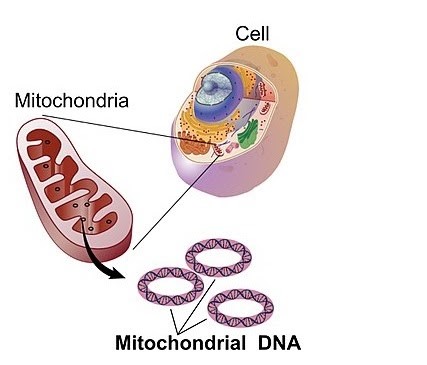
Historical records are not enough to give detailed information about women’s history. The mtDNA test provides more information by analyzing female-inherited mitochondrial DNA. It allows you to learn more about your maternal heritage by tracing your female lines back through multiple generations.
mtDNA refers to what form of testing? The mtDNA test traces a person’s matrilineal or mother-line ancestry using the DNA in their mitochondria. Unlike the Y-DNA, which is only passed from father to son and not to daughters, the mtDNA is passed from the mother to all her children, including males and females. This means that people of either sex can take the test. If a perfect mtDNA match is found with another person’s DNA, they may be related.
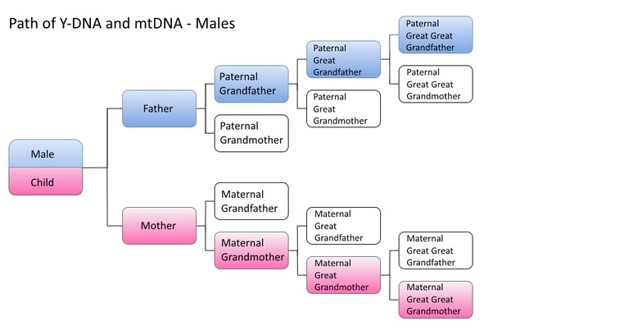
However, the fact that males inherit this DNA from their mother doesn’t mean they can transfer it to their children since males transfer Y-DNA and not mtDNA.
This is why the mtDNA test can reveal information about the mother, the mother’s mother, and so on but not the father. To trace a paternal line, a male would have to get tested with a Y DNA test (also called a Y chromosome test), which tests for STR markers, etc.
Who can take the mtDNA test?
The mtDNA test is meant for those who wish to learn more about their maternal lineage. Both males and females can take the mtDNA test to discover relatives. Just remember, you will only be finding relatives on your maternal side. It can also be taken to understand your susceptibility to a particular disease.
Note that the test is not meant for those who want to learn about their paternal lineage since mitochondrial DNA is only passed through the mother’s line.
What can you discover from the mtDNA test?
Some of the things you can discover from the mtDNA test include:
Your female ancestors country of origin
This test can provide information about which country your grandmother or her mother came from. Some can go deeper to tell you the tribe or ethnic group they belong to. An advantage of mtDNA testing over autosomal testing is that the former’s DNA ethnicity results can explore beyond two generations. It can dig deeper to educate you about your long-distant maternal ancestors like your great-great-great-grandmother.
mtDNA testing is especially useful to uncover records that have missing or scarce information. Much of the scientific research on mtDNA has come from the Cambridge Reference Sequence (CRS), which was announced in 1981. This reference sequence is often used for comparison purposes in some DNA tests.
Susceptibility to disease
A lot is encoded in the DNA. Therefore, by performing an mtDNA test, you can find out if you’re susceptible to a particular disease like your maternal ancestors or not.
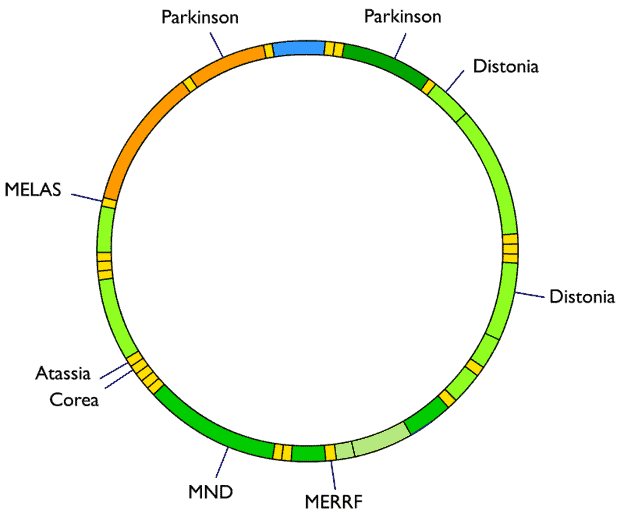
Your relatives
You can discover your long-distant family from a genealogical DNA test, like mtDNA testing, through DNA matching. That is, if your unique result matches that of someone else, it means you may be related to them through one of your maternal ancestors.
The science of the mtDNA test
HVR regions
When you take an mtDNA test, one or more of three parts of your DNA is being analyzed. Thus, to better understand the science of how this test works, you must first understand the parts that the test analyzes. They include:
- HVR1
- HVR2
- Coding region
HVR stands for Hyper Variable Region. If the test looks at HVR1, it means it analyzes the small set of base pairs found at the end of the DNA strand. If it looks at the HVR2, it means it analyzes the small set of base pairs found at the beginning of the DNA strand. Some tests analyze the coding region. The coding region is the large central part found between the HVR1 and HVR2 of the DNA strand.
HVR1 and HVR2 regions change more often than the coding region. However, this doesn’t mean they change every day or every year. Sometimes, these two ends on mtDNA mutate once in fifty generations.
The two most common mtDNA tests analyze either the HVR1 region, the HVR2 region, or both. Originally, it was expensive to sequence DNA so companies offered one or the other. As prices drop, most reputable companies now perform mtDNA HVR1, HVR2 tests that analyze both at a minimum. However, if you need a better result with a high accuracy, you should look for laboratories that test all the parts, including the HVR1, HVR2, and the coding region.
When all three regions are tested, it is called an mtDNA full sequence test and goes by the name mtDNAFullSequence, the Mega Test, or the full mitochondrial sequence (FMS) test. An FMS test reports results for all 16,569 bases in the mtDNA genome. If two people have an exact FMS match they will generally share a common ancestor within the last 22 generations (about 550 years). It is the best option.
Family Tree DNA and Genebase offer FMS. Other companies, such as 23 and Me and Living DNA, will use microarray technology to analyze predetermined single nucleotide polymorphisms (SNPs) on the entire mtDNA. Some downsides to this technology used by companies such as the 23andme mtDNA test, is that these companies only provide the major haplogroups. Additionally, since these companies provide autosomal YDNA and mtDNA tests, they tend to have a smaller focus on genealogy research.
In collaboration with FamilyTreeDNA, Nebula Genomics will give you deep ancestry dives using mtDNA data from one of the most reputable companies in genetic genealogy. You can also upload your Nebula Genomics raw mtDNA test results to YFull to receive reports related to your mtDNA sequence.
Haplogroups
The mitochondrial DNA shows your haplogroup. The haplogroup is a group of people that has a common ancestor. You can identify each of the major haplogroups with a letter. For more specificity, the letters are followed by one or more numbers or letters. This helps to narrow the haplogroup into smaller groups making it easy to find your ancestor.
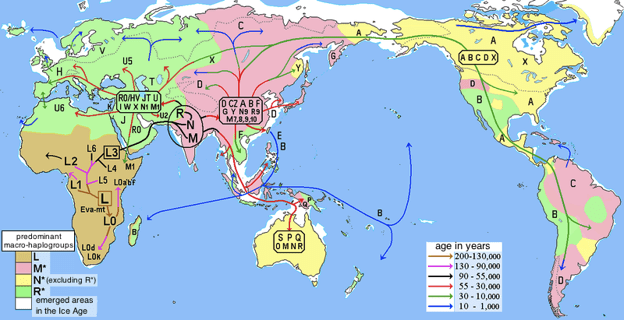
Overall, mtDNA only sequences a relatively small percentage of the entire human genome. But remember, while most autosomal DNA tests can only trace lineage a few hundred years, mtDNA analysis allows you to go back thousands of years.
mtDNA is also useful for filling in missing or scarce records. For example, Native American haplogroups tend to be distinct from others. If your mtDNA haplogroup matches those historically found in North or South America, you can be confident that you have some Native American ancestry, even if there is little to no documentation.
Performing an mtDNA test with FamilyTreeDNA
FamilyTreeDNA is one of the most reputable companies you can trust to offer you a quality mtDNA test service. Their prices are reasonable and their primary focus has always been on genetic genealogy.
Taking a FamilyTreeDNA mtDNA test
The process involved in doing a mitochondrial DNA test at FamilyTreeDNA is easy. You can start and complete the process in the comfort of your home.
You can order mtDNA test kits directly from the company’s website, input your shipping location, and It will be delivered to you.
You will collect your DNA sample from the inner cheek using a cheek swab that comes included with the sample collection kit. It’s important to avoid sample contamination. Your sample can be contaminated if the swab touches any other surface of the body such as the skin or other objects. Thus, you should prevent it from touching such parts before and after collecting the sample. A contaminated sample may affect result accuracy.
Mail back the sample to the company and they will perform the test.
mtDNA test cost
You will get the mtDNA test kit from FamilyTreeDNA for $159. This makes the mtFull Sequence test cheaper than what most other DNA testing companies offer.
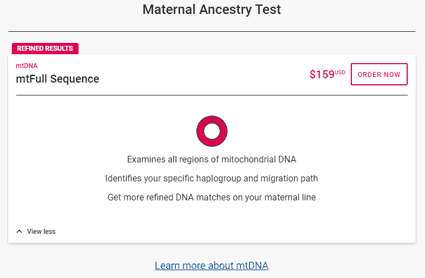
mtDNA results
Your mtDNA result will be ready between 6 to 8 weeks after the lab receives the sample. They will notify you through email when your result is ready. You can then login into their website to download you result.
FamilyTreeDNA breaks down their results into two main sections: discovering ancestors and tracing your maternal line through migration patterns.
Discovering ancestors is performed through DNA matching that compares your unique DNA pattern with others in the world’s largest mtDNA database. Through determination of your haplogroups, FamilyTreeDNA allows you to trace migration patterns and determine where your maternal ancestors lived, going back thousands of years. This type of tracing can be especially useful for people of Native American or African American descent, when records can be scarce or lost.
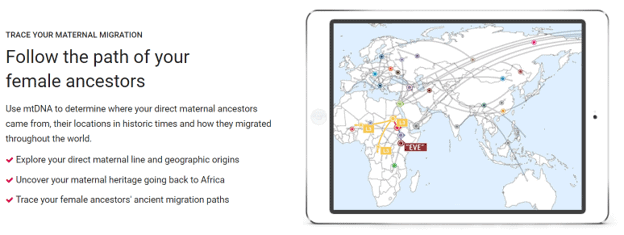
Nebula Genomics
Nebula Genomics is not like the usual DNA test you may know. We offer unique mitochondrial DNA tests and provide quality results. Many ancestry tests only decode 0.02% of your DNA, but that is not the case with Nebula Genomics. We decode 100% of your mitochondrial DNA, which explains why and how we offer reliable results. Our collaborations with FamilyTreeDNA and YFull mean that you also get the best mtDNA test with the most reliable and in depth analysis of your maternal line. Males can analyze their paternal lineage with Y DNA tests through these same means.
We understand how well you want your privacy protected; thus, we offer excellent privacy protection. We don’t allow third-party access to your information without first seeking the customer’s consent. You can begin your journey of discovery without risking the privacy of your most personal information.
Since we decode 100% of your DNA, you can discover much more than your maternal line. We also allow our customers access our powerful, browser-based genome exploration tools. With them, you can find answers to any question you have about your DNA. Our 30X Whole Genome Sequencing data is of the highest quality and can be used by physicians and genetic counselors.
Edited by Christina Swords, PhD
